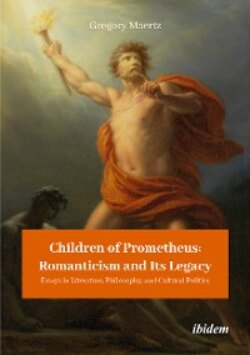Читать книгу Children of Prometheus: Romanticism and Its Legacy - Gregory Maertz - Страница 5
Preface and Acknowledgements
ОглавлениеOver the years, colleagues, students, and friends have urged me to collect and publish in one place essays that were scattered in various journals and anthologies, and thus, with this volume, I have done so. From early attempts at emulating the belletristic verve of my first teachers—Erich Heller, Harry Levin, and W.J. Bate—to more rigorously scholarly work, which incorporates the example of my Ph.D. mentors, James Engell and Jerome H. Buckley, these essays map the intellectual journey taken from my undergraduate days through graduate school and into the early years of my academic career. Besides reflecting the personal evolution of one who owed his rescue from a chaotic childhood to courses on literature and art into a politically engaged scholar on the faculty of a minority-majority urban university, these essays represent a sustained effort to understand the revolutionary cultural dynamism unleased by Romanticism which continued to be felt for more than a century.
Beginning with an assessment of Arthur Symonds’s critique of Sir Thomas Browne, “The Paradox of Faith in Sir Thomas Browne and Kierkegaard,” which resonates with the values of the Aesthetic Movement (inspired by Victorian admiration of the sonically lush poetry of John Keats), and then culminating in “From Translation to Authorship: Anglophone Women Writers and Goethe,” a survey of the formative impact of Goethe’s works in Britain and America, the essays in between mark some of the forms in which the legacy of Romanticism was expressed in English, German, and Russian. The first five essays are categorized as “comparative” because in each of them one or more works are compared with others. In all of them, acknowledged or unconscious affinity—between Browne and Kierkegaard, William Godwin and his daughter Mary Shelley, Tolstoy and Schopenhauer, the poet Rainer Maria Rilke and the sculptor Auguste Rodin, and the poets Osip Mandelstam, Rilke, and David Jones—forms the basis for ideological and formal comparison. The last four essays are organized under the heading of “cultural politics.” Each of them seeks to illuminate and better understand the fusion of literature, philosophy, and politics associated with writers in the Godwin Circle in Britain and Transcendentalism in New England with an appreciation of the central role that anglophone women writers played in the reception of Goethe.
Uniting the diversity of cultural activity discussed and analyzed in this collection of essays is the Titan god Prometheus, in whose double aspect as “fire bringer” (Pyrphoros) and “creator” (Plasticator) of humankind out of earth and water is embodied the qualities synonymous with the Romantic Movement—rebellion, defiance, suffering, endurance, and martyrdom, which are combined with creativity and altruism. Above all, Prometheus, who animated the homunculi that he molded with the fire that he had previously stolen from heaven, is a symbol of the struggle against arbitrary, abstract, oppressive authority, which includes rejection of the international Enlightenment consensus on taste, decorum, and acceptance of hereditary autocratic rule. The Promethean fire that energizes and gives rise to much of the cultural production discussed in this book was generated by German writers and thinkers—Kant, Goethe, Schopenhauer, and Nietzsche—who inspired and empowered writers in combination with the revolutionary political, social, and cultural forces of liberation unleased in the American colonies in 1776 and in Paris in 1789. The resulting literary and philosophical works are the figurative offspring of Prometheus signaled in the title of this book.
The research represented in these pages was generously funded by an I.A. Levin Fellowship at Harvard University, an Andrew W. Mellon Postdoctoral Fellowship at Washington University, and a Jackson Fellowship at the Beinecke Library. Early versions of these essays appeared previously, and the author and publisher are grateful to the editors of The University of Mississippi Studies in English, the Wiener Slavistisches Jahrbuch, the European Romantic Review, the SB Academic Review, and 1650–1850 for permission to publish revised versions here. Unless otherwise noted, all translations are my own. I wish to thank Valerie Lange and Malisa Mahler at ibidem for their editorial and design expertise. As ever, I am profoundly indebted to my colleagues and students in the English Department at St. John’s University for both moral and material support.
Cider Creek House
Griggstown, New Jersey
